|
63. Polyommatus coridon (Poda, 1761) / Chalkhill blue / Lycaenidae – Polyommatinae
NL: bleek blauwtje / D: Silbergrüne Bläuling, Silber-Bläuling / F: argus blue nacré
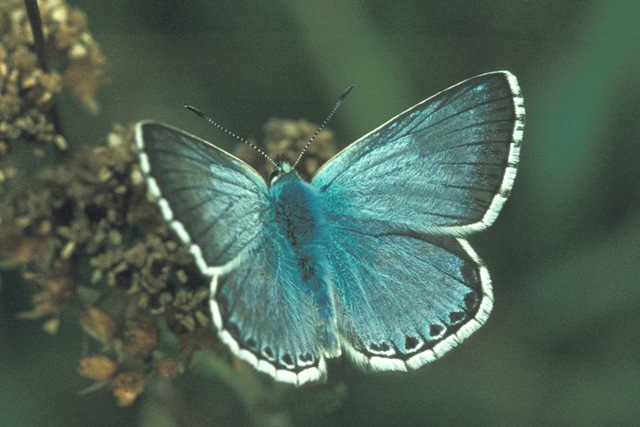 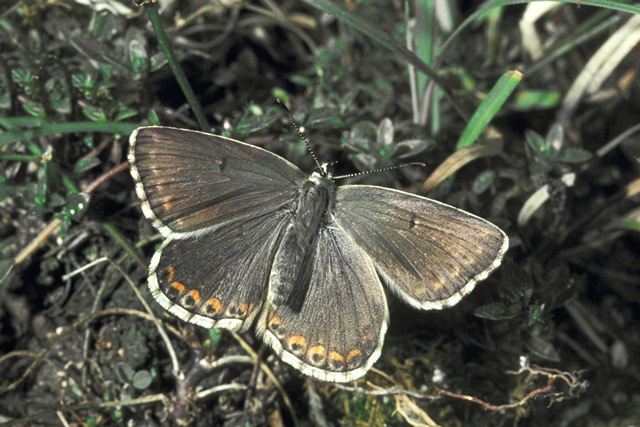 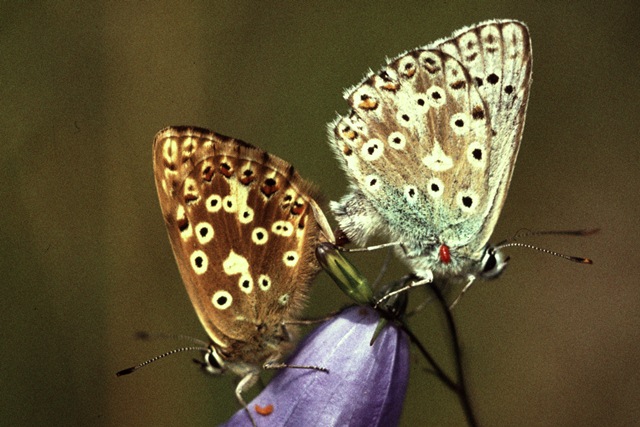
Photographs: Frits Bink ©.
Small, wing length 17 (15-18) mm. In the Benelux, it occurs on chalk grassland where its food plant horseshoe vetch grows. In Wallonia and Luxemburg it has several populations, in Flanders and in the Netherlands it is only known as a vagrant.
Butterfly is on the wing from early-July until mid-September, peaks early -August. It known from maritime to continental climates, amplitude 6 to 16. Required heat sum 700°d and maximum tolerated 2000°d, corresponding climate windows 24 and 38 weeks.
This blue is remarkable because of its very slow growing larvae, causing the butterfly to appear late in the summer. In southern countries it is well known for large congregations of male butterflies on excrement or at a drinking place on wet sand.
In England this species survives only on chalk grassland grazed at the correct intensity by cattle (Asher et al. 2001: 164-167).
Ecological characteristics
Behaviour over time
Overwintering: egg on woody part of the host near to the ground.
Reproduction: oviposition starts after 10-14 days when the body contains 66 (52-72) eggs, estimated production 3.3 times as much.
Larval feeding periods: 15-19 weeks in period from end-February until early-July.
Generations: one.
Spreading of risk: not observed.
Life cycle: egg 26-34 weeks; larva 128 (105-132) days; pupa 28 (21-32) days.
Life span of adult: long, at least 4 weeks.
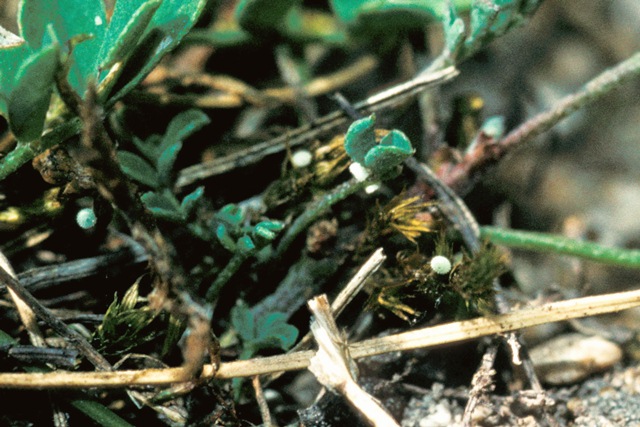 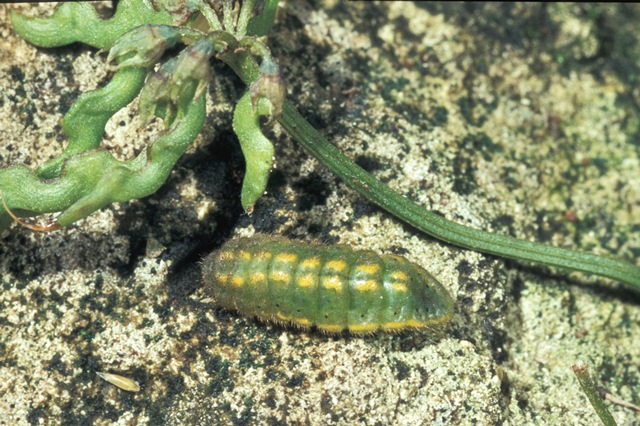
Photographs: Frits Bink ©.
Behaviour in space
From stay-at-home to migrant: stay-at-home, spatial requirement modest.
Finding a mate: male perches and also joins congregation at drinking place or roost.
Orientation in the landscape: on warm and dry places with a mixed vegetation.
Oviposition: on stems of the host near to the ground.
Defence
Threats from other organisms: larva hides in the vegetation and profits from guarding by ants.
Myrmecophily: very strong, full array of ant-attracting and appeasing organs, larvae are tendered by ants and fully grown larvae often hide in ant nests.
Threats from the environment: endure heat and drought quite well.
Feeding habits
Adult: all kind of flowers, particularly carline thistles.
Larva: very small larva mines in thick leaf, fully grown ones hide in the vegetation near the host plant and moves every day from host to shelter place.
Larval foodplants
Plant species: Fabaceae, Hippocrepis comosa.
Journal
Rearing experiments based on specimens from Seyssel, Haute Savoie, France:
4 September 1984: female captured.
9 September: c. 10 ova had been laid on stems of potted H. comosa.
Overwintering outdoors.
25 February 1985: eggs hatch on second warm day after a frosty period.
4 March: larvae not seen but mining activity seen on thick young leaves.
29 March: larvae still first instar.
10 May: 5 larvae in third instar, hidden in the litter layer.
22 May: biggest larva 9 mm in length (last instar?).
11 June: one larva discovered in nest of ants (Lasius niger) at the bottom of the pot.
21 June: two larvae pupated.
2 July: last larva pupated.
12 July: first adult appeared, male.
3 August: last pupa hatched, female.
Table 63-1. Results of dissections

Table 63-2. Collection and observation localities
D, Lorch, 300m, 50° 02’ 05”N – 7° 47’ 56”E; 31July 1985.
F, Aurel, 400 m, 44° 43’N – 5° 16’E; 29 August 1984.
F, Averdon 47° 39’ 38”N – 1° 17’ 23”E; 30 August 1982.
F, Lorraine, Dieue-sur Meuse 49° 05’ 11”N – 5° 27’ 25”E; 19 August 1984, 5 September 1984.
F, Maison-du-Bois 46° 57’ 57”N – 6° 25’ 17”E; 24 August 1984.
F, Montmédy, 217 m, 49° 31’ 07”N – 5° 21’ 33” E; 18 August 1984.
F, Seyssel 45° 58’N – 5° 50’E; 4 September 1984.
F, Vosges, Bollenberg, 363 m, 47° 56’ 54”N – 7° 15’21”E; 25 July 1983.
F, Vosges, le Zinnkoepfle, 481 m, 47° 57’ 56”N – 7° 15’ 08”E; 22 August 1984.
GB, Dorking 51° 14’ 32”N - 0° 21’ 13”W; 23 July 1981.
Fig. 63-1. Polyommatus coridon, phenogram adapted from Fichefet et al. 2008: 137.

Fig. 63-2. Polyommatus coridon, habitat characteristics.
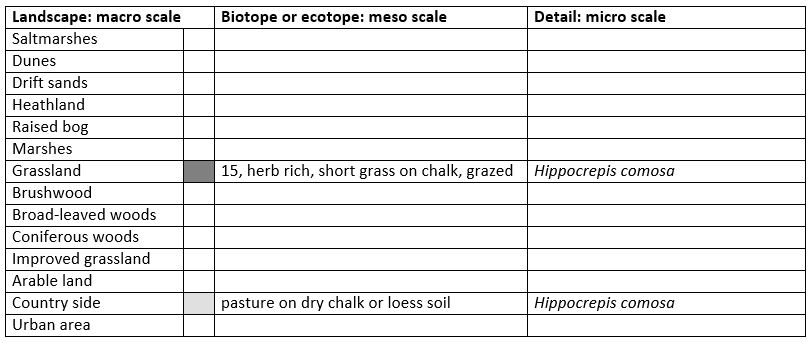
Fig. 63-3. Polyommatus coridon, climate matrix, heat-sums 700 - 2000°d.
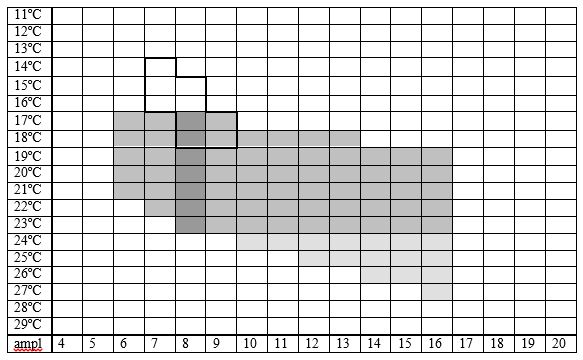
|










